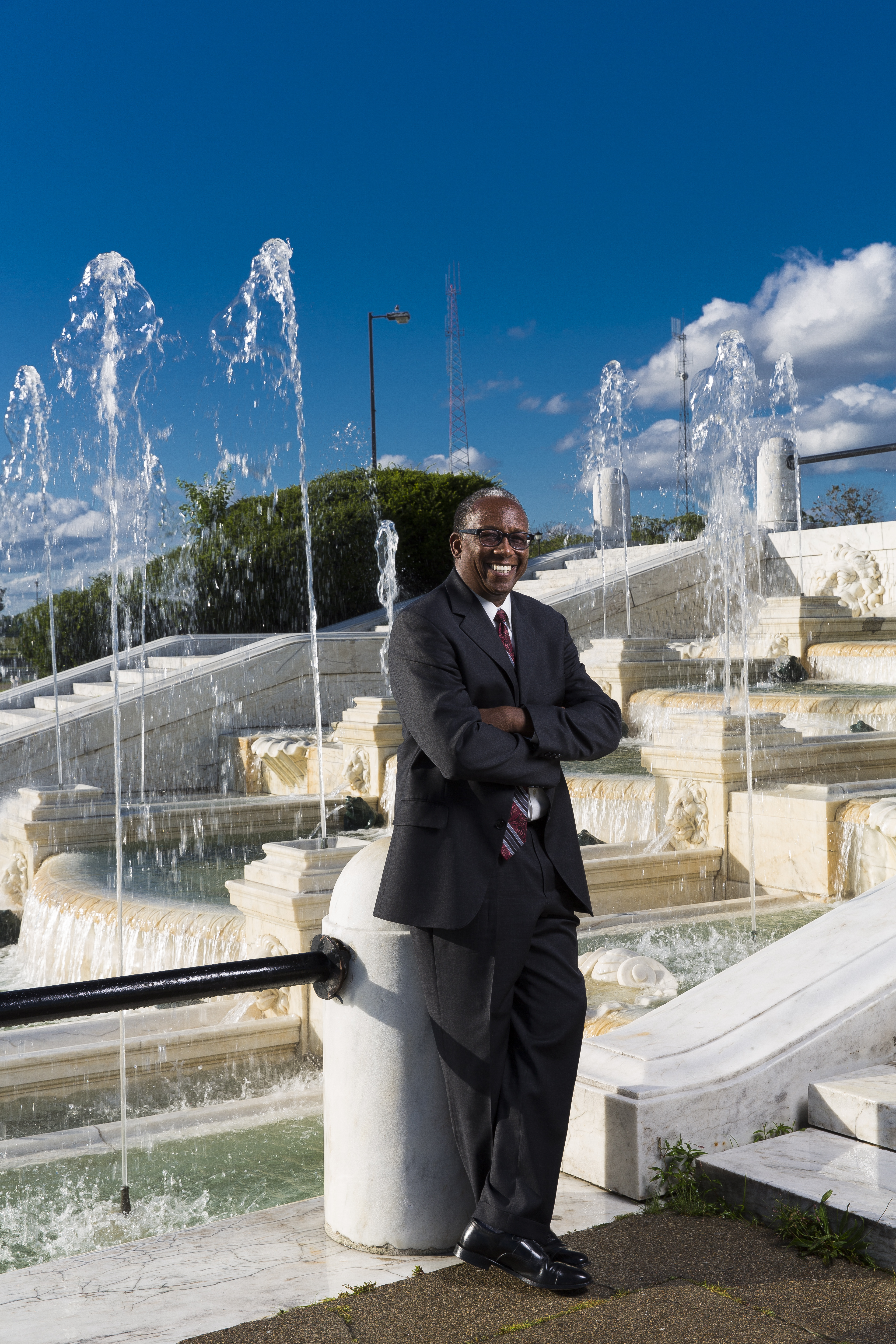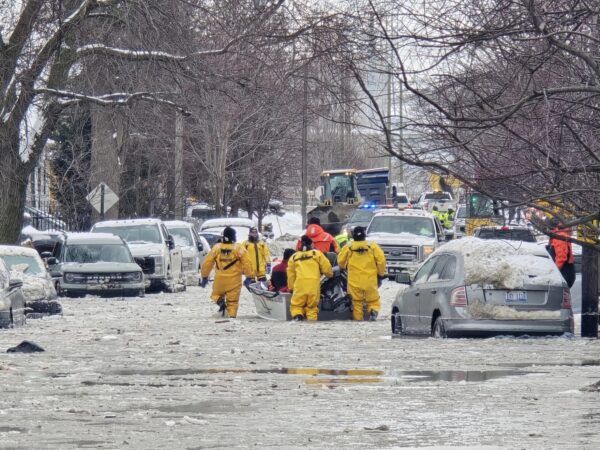
Great Lakes Moment is a monthly column written by Great Lakes Now Contributor John Hartig. Publishing the author’s views and assertions does not represent endorsement by Great Lakes Now or Detroit Public Television.
Guy O. Williams knew very little about the Great Lakes growing up in Lanham, Maryland, about 10 miles northeast of Washington, D.C.

Guy Williams, environmental justice champion in Detroit, Mich. (Photo credit: David Lewinski/Bucknell Magazine via John Hartig)
He acquired a love of nature walking through forests and meadows near his home. Soon, science and math classes caught his attention and he started questioning why society wasn’t a better steward of the natural resources he had grown to love. He obtained his B.S. from Bucknell University, a small liberal arts college in Pennsylvania. His faith and life journey had not been easy as he struggled with and overcame drug and alcohol addiction. Over the years, he worked for a range of well-known environmental advocacy organizations – the Environmental Defense Fund, National Wildlife Federation and Detroiters Working for Environmental Justice.
He went on to become nationally recognized as an advocate for environmental justice and a developer of community programming that values effective collaborations among business, government and community interests.
Environmental Defense Fund
In 1989, Williams took his first job in the environmental movement, with the Environmental Defense Fund in Washington, D.C. A leading national nonprofit organization representing more than 2.5 million members, EDF is dedicated to preserving the natural systems on which all life depends. Looking back, Williams felt it was the hand of God putting him in the EDF office at that time.
Williams first became aware of environmental justice working at EDF. Environmental justice is making sure everyone has a safe place to live, work and play.
“But unfortunately, there’s also a world of great environmental injustice, and it’s people of color who get the short end of the stick,” Williams noted.
In 1990, several environmental justice leaders signed letters accusing 10 of the largest and most influential environmental groups (then called the “Group of 10”) of racism in terms of their policy development, hiring and the composition of their boards. These were not just any nongovernmental organizations, but ones with national and international footprints, like National Wildlife Federation, EDF, Sierra Club, Audubon Society and more. The letters challenging these groups to address environmental issues experienced by people of color and the poor received much attention and even made national news by being featured in The New York Times.
After looking into the allegations against EDF, his employer, Williams considered them to be true.
“Rather than leaving EDF, I decided stay and become part of the solution,” Williams said.
It was a life-changing moment. He then channeled his intellect, street smarts, passion and commitment into a 30-year career of fighting for environmental justice for all. It put him on the front lines of engaging businesses that would typically be called the polluters, exploring how they could be more environmentally safe for all people and species.
While working at EDF for four years, Williams was exposed to many outstanding people who expanded his horizons and inspired him, including Mark Van Putten, then president and chief executive officer of National Wildlife Federation’s Great Lakes Resource Center in Ann Arbor. With mutual shared values, Van Putten mentored, encouraged and inspired Williams to follow his passion and believe in his vision. At the first staff meeting when he realized that Native populations were not included in the people that would benefit from a lawsuit settlement, Williams voiced serious disapproval. Van Putten heard him, and the necessary adjustment was made.
Soon Williams became the EDF point person for planning the first National People of Color Environmental Leadership Summit on October 24-27, 1991, in Washington, D.C. This summit attracted 500 delegates. Most significant was that delegates drafted and adopted the 17 Principles of Environmental Justice. These principles have gone on to guide and nurture the growing grassroots movement for environmental justice.
National Wildlife Federation
Subsequently, in 1994, Williams was recruited by Mark Van Putten to take a position at the National Wildlife Federation in Ann Arbor to help further a pollution-prevention program. It would be difficult and challenging work because it was pursuing a goal of “virtual elimination of the discharge of persistent toxic substances” with a philosophy of “zero discharge” as called for in the 1978 U.S.-Canada Great Lakes Water Quality Agreement.
But it took a lawsuit focused on improving water quality in the Great Lakes and reducing discharges from Detroit’s wastewater treatment plant to put Williams on the map as an environmental innovator and collaborator in preventing pollution at its source. Williams and his team documented that high levels of mercury were being released from Detroit’s regional sewer system and recommended methods for controlling it while the lawsuit was argued over several years.
Among the evidence presented as part of the lawsuit, the team documented that in 1995 four pounds of mercury were being discharged into the Detroit River each week. Health advisories were in effect on human consumption of mercury-contaminated fish, and women of child-bearing age and children were advised against consuming any of these contaminated fish.
“We figured that if we could clean up that one major source of mercury in the Great Lakes, it would be a great victory and would be a model for others to follow,” Williams said.
This lawsuit provided a unique opportunity to experiment with collaborative pollution-prevention strategies. Williams’s critical thinking and skills in collaboration led to a major victory in preventing the release of mercury. By the time the lawsuit was settled in 2002, the defendants agreed to implement the changes sought by Williams and his team at NWF. Eventually, cities around the country replicated the same mercury pollution prevention strategies, resulting in some of the strictest environmental protections in the United States.
They worked with hospitals and dental offices to identify and implement practical and economical ways of reducing mercury use in the healthcare industry. This included:
- conducting inventories to identify sources of mercury within their facilities;
- making recommendations to existing hazardous waste and safety committees and the administration for reducing or eliminating these sources;
- instituting immediate steps for mercury reduction; and
- devising long-term goals for the virtual elimination of mercury from their facilities.
Their seminal work was heralded as one of the first collaborative pollution-prevention strategies in the country and even helped catalyze a new organization called Health Care Without Harm, now a group with international impact.
The results were compelling, including the prevention of hundreds of pounds of mercury from being released from dental offices each year to the municipal sewer system. A partnership between NWF and the Michigan Hospital Association was groundbreaking in reducing mercury use in the healthcare industry and became a model for others to follow. The Henry Ford Hospital incinerator closed because of community action to address emissions, including mercury and other chemicals generated from the burning of plastics, and mercury thermometers were banned.
Detroiters Working for Environmental Justice
The same year Williams came to Ann Arbor and took the job with NWF, he met others in Detroit who were working on environmental justice issues. He quickly fell in love with Detroit, and its people stole his heart—those with no or very limited opportunities, those living in unsafe neighborhoods in the shadows of heavy industries, and those with little apparent influence on governmental and corporate policies that impact their lives.
As he met people and made connections, it helped shape how he would apply his spiritual mission in Detroit. He and like-minded Detroiters organized Detroit’s first Environmental Justice Gathering in June 1994 to explore what they could do together. Out of that gathering came Detroiters Working for Environmental Justice, a nonprofit organization that provides all Detroit residents with the tools they need to address environmental concerns in their own neighborhoods. They did not want to simply redistribute environmental harms but to abolish them.
“The people who formed the nucleus of DWEJ were already there and working,” Williams noted. “They were a source of inspiration to me and welcomed me into their body of work. For that, I am forever grateful.”
A founding member of DWEJ who has maintained an active presence in the organization, Williams was named president and chief executive officer in 2010. Under his leadership and with the support of many, DWEJ has grown from a grassroots volunteer organization to a major voice recognized locally, statewide and nationally for its innovative programs and projects that create sustainable, livable communities. As an early environmental justice organization in Michigan, its work is woven into the fabric of every Detroit neighborhood. Examples of DWEJ activities and leadership include:
- In 2017, DWEJ wrote and published the city’s first climate action plan after many years of working with representatives from nonprofit, educational, business and governmental organizations, as well as people in all Detroit neighborhoods.
- After years of advocacy by DWEJ and others, an Office of Sustainability was established within Detroit City government in 2017.
- DWEJ provided key leadership for and participated in the development of the Detroit Sustainability Action Agenda in 2019.
- To help demonstrate action, DWEJ has established Future Build Construction Group to help break the cycle of poverty by giving Detroit residents the skills to work in living-wage jobs with a focus on repairing and protecting the environment.
- For decades DWEJ has been promoting environmental justice through education, building relationships and shaping policy.
Broad impact across broad issues
Guy Williams has been a shining light for environmental justice in Detroit for 25 years. He has worked both in the trenches and in the boardroom and been involved with most of the significant green initiatives in Detroit. He has been at the crossroads of energy, water, jobs, safety, air quality, green technology, recycling, land use, community and more—all the while mentoring the next generation of environmental justice champions.
Williams’s impact has been as broad as his knowledge. He serves as chair emeritus of the Great Lakes Leadership Academy board of governors. He also serves on the board of directors of the Rails-to-Trails Conservancy (chair from 2013 to 2016) and has served on the advisory board for the Center for Urban Responses to Environmental Stressors, the Detroit Urban Research Center and the Great Lakes Integrated Sciences and Assessment Center.
In recognition of his many accomplishments, Williams was named a Michigan Green Leader by the Detroit Free Press in 2014. In 2016, he received the Bucknell University Alumni Association Award for Service to Humanity followed in 2017 by the William Milliken Leadership for the Common Good Award. He is known locally and nationally for his environmental justice advocacy and for innovative community programming that values effective collaborations among business, government, and community interests.
Richie H. Harrison, member of the board of directors of DWEJ and co-director of the Great Lakes Leadership Academy had this to say about his colleague and friend:
I have tremendous appreciation for Guy Williams and his work through Detroiters Working for Environmental Justice. As a team member and collaborator, I have come to appreciate Guy as a leader and innovator in the space of environmentalism, environmental advocacy and justice. He has supported impactful projects that have improved the health and well-being of Detroiters and beyond. Moreover, early in my career, Guy took the initiative to reach out to me while we were on a project committee together. He expressed an appreciation for my skills as an emerging leader, which gave me a huge boost in confidence. He backed his words by becoming my mentor, supported my growth and encouraged me to pursue opportunities that helped to further my development. I have a deep appreciation for Guy and his impact. He has shown the vision to support Detroit’s communities, invest in future leaders and build a legacy regarding the role of environmental justice for the City’s future.
“My dream is to see a city that is vibrant across all aspects of the society—a place where the current disparities of power, wealth and education are greatly reduced, and where the voices of the people-at-large are always heard and respected by decision makers,” Williams said. “I try to do my part toward this end, day in and day out.”
Recently, Williams stepped down as president and chief executive officer of DWEJ. But his retirement is only the beginning of the next chapter of his faith and life journey. He feels called to spend more time with his family and new grandchildren as he remains open to finding new ways to stay engaged for the good of the community.
And one thing I am certain of is that he will continue to be a shining light!
Read more Great Lakes Moments on Great Lakes Now:
Great Lakes Moment: Warmer, wetter, wilder
Roller Coaster: Michigan’s long history with environmental contamination
Great Lakes Moment: Investing in pollution prevention and restoration pays off
Great Lakes Moment: River otters return to western Lake Erie
Great Lakes Now Contributor John Hartig is a board member at the Detroit Riverfront Conservancy. He serves as the Great Lakes Science-Policy Advisor for the International Association for Great Lakes Research and has written numerous books and publications on the environment and the Great Lakes. Hartig also helped create the Detroit River International Refuge, where he worked as the refuge manager until his retirement.
Featured image: Zug Island is an intensively industrialized landmass in southwest Detroit. (Photo credit: The Center for Land Use Interpretation, CC 3.0)
1 Comment
-
This article is filled with lies and omissions on the origin of DWEJ. The organization began at the kitchen table of its true founder Ms. Donele Wilkins and was taken from her in a hostile takeover with Guy WILLIAMS WHO SHE RESCUED playing a major role in kicking her out. I should note that this moved was made at just the moment that the organization received a few lucrative contracts and guy williams who did not have a job at that time became CEO. Those of us who are truly in the EJ Movement know this story all to well. How could you write this without naming the founder .This is not factual and is not history but I am certain that it is GUY ‘S story




